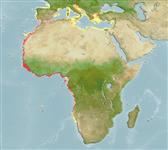Teleostei >
Clupeiformes (Herrings) >
Dorosomatidae (Gizzard shads and sardinellas)
Etymology: Sardinella: Latin and Greek, sarda = sardine; name related to the island of Sardinia; diminutive (Ref. 45335).
More on author: Lowe.
Environment: milieu / climate zone / depth range / distribution range
生态学
海洋; 半咸淡水 大洋性; 海洋洄游的 (Ref. 51243); 深度上下限 0 - 80 m (Ref. 27000). 亞熱帶的; 24°C - ? (Ref. 54872); 46°N - 23°S, 17°W - 36°E (Ref. 54872)
Atlantic Ocean: southern and eastern parts of Mediterranean Sea, also penetrating the Suez Canal (Ref. 188, 50345), and eastern Atlantic Ocean, from Gibraltar southward to Angola and a single recorded specimen from Walvis Bay in Namibia (Ref. 188, 5286, 81269, 81631, 86940).
東大西洋: 直布羅陀到安哥拉; 單一標本從那米比亞的沃爾維斯灣記錄。 也已知來自地中海。 (南部和東部部份, 也穿透蘇伊士運河)
Length at first maturity / 大小 / 重量 / 年龄
Maturity: Lm 13.4, range 11 - 19.5 cm
Max length : 30.0 cm SL 雄鱼/尚未辨别雌雄; (Ref. 188); common length : 25.0 cm SL 雄鱼/尚未辨别雌雄; (Ref. 188); 最大体重: 927.00 g (Ref. 3808)
背棘 (总数): 0; 背的软条 (总数): 18-23; 臀棘 0; 臀鳍软条: 17 - 23; 脊椎骨: 44 - 48. Diagnosis: Body elongate, but variable in depth, belly fairly sharply keeled; with 14-20 pre-pelvic and 12-15 post-pelvic scutes, total scutes 31-34; lower gillrakers 70-166, increasing with growth; upper pectoral finrays white on outer side, the membrane between black (Ref. 188, 3259, 81269, 81631). It resembles Sardinella aurita, but pelvic fin with 1 unbranched and 7 branched rays vs. 1 unbranched and 8 branched rays in S. aurita and no black spot on hind part of gill cover, but faint gold or black area just behind gill opening (Ref. 187, 188). It is distinguished from S. rouxi by having more lower gillrakers, which is only 30-40 in S. rouxi, and the caudal fin grey, its tips almost black vs. pale yellow with distal margin dusky in S. rouxi (Ref. 187, 188, 81269).
身体可变的分之一深度, 腹面相当龙骨了; 总鳞甲 31 到 34.(14-19个前腹鳍,12-14 后) 下鳃耙 70 到 166.(在鱼 6个公分标准长度或更多中) 在外部的侧边上的上面的胸鳍鳍条白色, 在黑色之间的薄膜。 尾鳍灰色的, 它的顶端几乎黑色的。 模糊的黄金或黑色的区域在鳃裂正后方。
A coastal, pelagic species, but tolerant of low salinities (Ref. 188, 5286, 27000, 86940); sometimes in estuaries and lagoons (Ref. 188, 2683). It forms schools, preferring waters of 24°C, at surface or at bottom down to 50m, strongly migratory (Ref. 188, 5286). It feeds on a variety of small planktonic invertebrates, also fish larvae and phytoplankton (Ref. 188, 27165). It breeds only once in the year, during the warm season between July and September, in coastal waters; juveniles and adults show clear north-south migrations in the Gabon-Congo-Angola sector and the Sierra Leone-Mauritania sector of the Atlantic Ocean, each area having nurseries; these movements are correlated with the seasonal upwelling (Ref. 188). It is of considerable importance off West African coasts, but combined with Sardinella aurita in most statistics, partly because both species are often caught together (Ref. 188).
在沿岸水域中形成鱼群,偏爱 24个 ° C. 的水域 吃多种小的浮游性无脊椎动物,仔鱼与浮游植物。 在温暖的季节 (七月-九月) 期间进行繁殖。 稚鱼与成鱼显示在加蓬清楚的南北回游-他们的范围的刚果-安哥拉地区以及在塞拉利昂-毛里塔尼亚的地区中, 每个区域有育幼。 运动是与季节性的涌升流有关的。 在市场上销售生鲜地了, 冷冻或盐腌的。
Life cycle and mating behavior
成熟度 | 繁殖 | 产卵场 | 卵 | 孕卵数 | 仔鱼
東大西洋: 直布羅陀到安哥拉; 單一標本從那米比亞的沃爾維斯灣記錄。 也已知來自地中海。 (南部和東部部份, 也穿透蘇伊士運河)
Whitehead, P.J.P., 1985. FAO Species Catalogue. Vol. 7. Clupeoid fishes of the world (suborder Clupeoidei). An annotated and illustrated catalogue of the herrings, sardines, pilchards, sprats, shads, anchovies and wolf-herrings. FAO Fish. Synop. 125(7/1):1-303. Rome: FAO. (Ref. 188)
人类利用
渔业: 高经济性; 诱饵: usually
更多信息
合作者照片Stamps, Coins Misc.声音神经毒速度泳型鳃区Otoliths脑重体重比眼睛色素
工具
特别资料
下载 XML
网络资源
Estimates based on models
Preferred temperature (Ref.
123201): 18 - 27.9, mean 21 °C (based on 208 cells).
Phylogenetic diversity index (Ref.
82804): PD
50 = 0.5000 [Uniqueness, from 0.5 = low to 2.0 = high].
Bayesian length-weight: a=0.00813 (0.00660 - 0.01002), b=3.03 (2.99 - 3.07), in cm total length, based on LWR estimates for this species (Ref.
93245).
营养阶层 (Ref.
69278): 3.2 ±0.38 se; based on food items.
Generation time: 3.2 (1.8 - 3.7) years. Estimated as median ln(3)/K based on 13
growth studies.
回复力 (Ref.
120179): 中等的, 族群倍增时间最少 1.4 - 4.4年 (K=0.34; tm=3; tmax=6).
Prior r = 0.57, 95% CL = 0.38 - 0.86, Based on 6 stock assessments.
Fishing Vulnerability (Ref.
59153): Moderate vulnerability (35 of 100).
Climate Vulnerability (Ref.
125649): Low to moderate vulnerability (32 of 100).
Nutrients (Ref.
124155): Calcium = 112 [59, 177] mg/100g; Iron = 1.65 [0.98, 2.68] mg/100g; Protein = 21.3 [20.4, 22.1] %; Omega3 = 0.457 [0.231, 0.866] g/100g; Selenium = 39.4 [20.0, 76.9] μg/100g; VitaminA = 30.2 [9.4, 98.4] μg/100g; Zinc = 0.755 [0.542, 1.131] mg/100g (wet weight); based on
nutrient studies.
